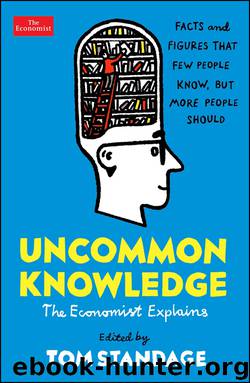Uncommon Knowledge by Tom Standage

Author:Tom Standage
Language: eng
Format: epub
Publisher: Profile
Published: 2019-10-22T16:00:00+00:00
What is sustainable finance?
Traditionally, investors evaluated their performance based on financial measures alone. But investing with an eye to environmental or social issues, not just financial returns, has become mainstream in the past decade. According to the Global Sustainable Investment Alliance (GSIA), an umbrella group, fully $23trn, or 26% of all assets under management in 2016, were in “socially responsible investments” that take account of environmental, social and governance (ESG) issues. But what counts as “sustainable investment” in the first place?
The nascent space still suffers from definitional quibbles: both over where to draw the line between sustainable and “normal” investments, and how to subdivide the universe of sustainable investment. The GSIA, for instance, counts seven distinct strategies. The least involved variant, and the one accounting for the greatest share of assets under management – around $15trn in 2016 – is “negative screening”, which simply excludes assets deemed unsavoury. An example would be a stock portfolio that otherwise tracks a broad index, but excludes the shares of tobacco companies or arms manufacturers. “ESG integration”, the second-largest category by the GSIA’s reckoning, involves taking ESG factors into account in the investment process, though the way investment firms do this in practice varies widely. Of the remaining strategies, perhaps the most interesting is “impact investment”, which has received a lot of attention recently. Although it is the smallest by assets, it is also by far the most ambitious. Impact investors only invest in projects or firms where the precise impact can be quantified and measured: for instance, the reduction in tonnes of carbon dioxide emitted by a firm’s factory, or the number of girls educated in a village school as a result of a particular project. These variants are quite different but most are set up on the premise that financial return need not be sacrificed in pursuit of non-financial goals.
As demand has broadened from rich individuals to institutional investors, mainstream financial firms have entered the space. Investors seeking ESG investment options can turn to BlackRock, the world’s largest asset manager, or the asset-management division of Goldman Sachs, a bank. Impact-investment firms used to be small and niche, but two of America’s largest private-equity firms, Bain Capital and TPG, have launched such funds. Offerings are available across asset classes, too. Bond investors can turn to a whole new asset class, that of “green bonds”, the proceeds of which are earmarked for environmental projects. (Issuance of such bonds rocketed from less than $500m in 2008 to over $160bn in 2017.)
Consistent measures and ratings are still a work in progress. For instance, many data providers now rate companies on ESG metrics, allowing investors to compare companies easily. Issuers of green bonds have long sought external validation of their environmental credentials. While the first certification schemes merely made a binary ruling on whether bonds were green or not, new methodologies seek to quantify the relative environmental impact. Measures that allow for comparison across investments are still lacking. The European Union wants to change that, and has
Download
This site does not store any files on its server. We only index and link to content provided by other sites. Please contact the content providers to delete copyright contents if any and email us, we'll remove relevant links or contents immediately.
Periodization Training for Sports by Tudor Bompa(8209)
The Body: A Guide for Occupants by Bill Bryson(5026)
The MacArthur Bible Commentary by John MacArthur(4782)
The Sports Rules Book by Human Kinetics(4339)
What It Really Takes to Get Into Ivy League and Other Highly Selective Colleges by Hughes Chuck(3715)
Marijuana Grower's Handbook by Ed Rosenthal(3640)
The Sprouting Book by Ann Wigmore(3561)
The Martian by Andy Weir(3352)
Salt, Fat, Acid, Heat: Mastering the Elements of Good Cooking by Nosrat Samin(3119)
The Bread Bible by Rose Levy Beranbaum(3035)
Harry Potter 4 - Harry Potter and The Goblet of Fire by J.K.Rowling(3030)
Sapiens and Homo Deus by Yuval Noah Harari(3027)
The Marketing Plan Handbook: Develop Big-Picture Marketing Plans for Pennies on the Dollar by Robert W. Bly(3005)
Classic by Mary Berry(2976)
Martha Stewart's Baking Handbook by Martha Stewart(2824)
Screenplay: The Foundations of Screenwriting by Syd Field(2598)
The Plant Paradox by Dr. Steven R. Gundry M.D(2580)
50 Economics Classics by Tom Butler-Bowdon(2544)
The Cambridge Grammar Of The English Language by Rodney Huddleston Geoffrey K. Pullum(2400)
